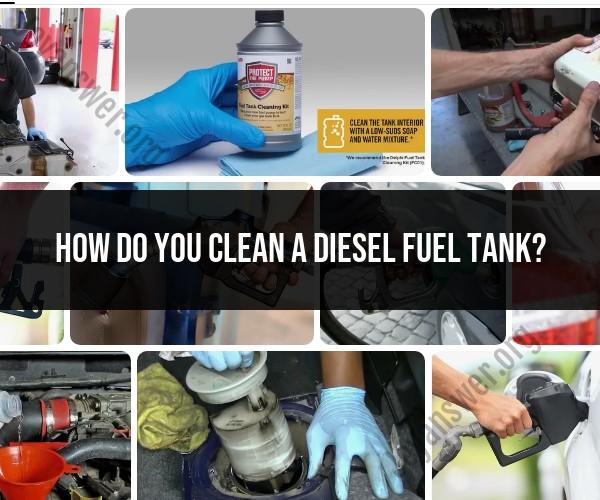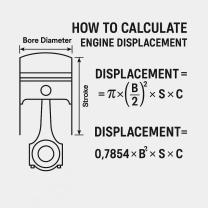How do you clean a diesel fuel tank?
Cleaning a diesel fuel tank is a task that should be performed with caution and safety in mind. It may be necessary if the tank has accumulated sediment, water, or contaminants that could affect the performance of the diesel engine or fuel system. Here's a step-by-step guide on how to clean a diesel fuel tank:
Note: This process can be complex and potentially hazardous, and it is recommended that it be carried out by professionals or individuals with experience in fuel system maintenance. Safety precautions, including wearing appropriate protective gear and ensuring proper ventilation, should be followed.
Tools and Materials You'll Need:
- Safety goggles and gloves
- Appropriate protective clothing
- A drain pan or container
- A fuel transfer pump
- Fuel hose
- A clean, dry cloth or rags
- A fuel filter
- Diesel fuel conditioner or biocide (if necessary)
- Cleaning solution (appropriate for fuel tanks)
- A fuel tank cleaning brush or fuel tank cleaning kit (if necessary)
- Sealing tape or sealant (if necessary)
- Tools for removing and reinstalling the fuel tank (if necessary)
Steps:
Safety Precautions:
- Ensure you are working in a well-ventilated area away from open flames or sparks. Diesel fuel is flammable, so safety is paramount.
- Wear appropriate safety gear, including safety goggles, gloves, and protective clothing.
Drain the Fuel Tank:
- If possible, drain the fuel tank completely into a suitable container or drain pan. This may require accessing the tank through a drain plug or fuel line.
Remove the Fuel Tank (if necessary):
- Depending on the vehicle or equipment, you may need to remove the fuel tank to access it for cleaning. Follow the manufacturer's guidelines and use appropriate tools.
Inspect the Tank Interior:
- Use a flashlight to inspect the interior of the tank for sediment, sludge, or contaminants. If there is significant buildup, consider using a fuel tank cleaning brush or cleaning kit.
Clean the Tank:
- If using a cleaning solution, follow the manufacturer's instructions for the proper dilution and application. Typically, you would add the solution to the tank, swish it around to dislodge contaminants, and then drain it.
Rinse the Tank:
- Rinse the tank thoroughly with clean diesel fuel to remove any remaining cleaning solution and contaminants.
Replace the Fuel Filter:
- Install a new fuel filter to ensure that clean diesel fuel enters the fuel system.
Add Diesel Fuel Conditioner or Biocide (if necessary):
- Depending on the condition of the tank and the climate, you may want to add a diesel fuel conditioner or biocide to prevent future issues with microbial growth or water contamination.
Reinstall the Tank (if removed):
- Carefully reinstall the fuel tank following the manufacturer's guidelines.
Refill with Diesel Fuel:
- Fill the tank with fresh, clean diesel fuel.
Test the System:
- Start the engine and check for any fuel system issues or leaks. Ensure the engine runs smoothly.
Dispose of Contaminated Fuel Properly:
- Dispose of any contaminated or old diesel fuel in accordance with local regulations.
Cleaning a diesel fuel tank is a task that should be approached with care and expertise. If you're uncertain or uncomfortable with the process, it's advisable to seek assistance from a qualified mechanic or professional with experience in fuel system maintenance.
Cleaning and Maintaining a Diesel Fuel Tank: Essential Steps
Cleaning and maintaining a diesel fuel tank is essential for keeping your diesel engine running smoothly and efficiently. Over time, diesel fuel can break down and form sludge and other contaminants that can clog fuel filters, injectors, and other components of the fuel system. This can lead to performance problems, increased emissions, and even engine failure.
To clean and maintain a diesel fuel tank, you should follow these essential steps:
- Drain the fuel tank. Use a siphon or drain plug to drain the fuel tank into a clean container. Be sure to dispose of the old fuel properly.
- Remove the fuel filter. The fuel filter is located at the bottom of the fuel tank. Remove it and inspect it for signs of contamination. If the fuel filter is clogged or dirty, replace it.
- Clean the fuel tank. Use a diesel fuel tank cleaner to clean the inside of the fuel tank. Follow the instructions on the product label.
- Rinse the fuel tank. Once the fuel tank is clean, rinse it with clean diesel fuel.
- Reinstall the fuel filter. Install a new fuel filter and refill the fuel tank with fresh diesel fuel.
How to Properly Clean and Service a Diesel Fuel Reservoir
To properly clean and service a diesel fuel reservoir, you should follow the following steps:
- Inspect the reservoir for signs of damage or corrosion. If the reservoir is damaged or corroded, it should be replaced.
- Drain the reservoir of all fuel. Use a siphon or drain plug to drain the reservoir into a clean container. Be sure to dispose of the old fuel properly.
- Clean the reservoir with a diesel fuel tank cleaner. Follow the instructions on the product label.
- Rinse the reservoir with clean diesel fuel.
- Reinstall the reservoir and refill it with fresh diesel fuel.
Preventing Contaminants in Diesel Fuel Tanks
To prevent contaminants from building up in your diesel fuel tank, you should follow these tips:
- Only use high-quality diesel fuel. Avoid using low-grade diesel fuel, which may contain more contaminants.
- Keep your fuel tank full. A full fuel tank helps to reduce condensation, which can lead to the formation of rust and other contaminants.
- Use a fuel additive. A fuel additive can help to prevent the formation of sludge and other contaminants in the fuel system.
- Have your fuel tank cleaned and serviced regularly. It is recommended to have your fuel tank cleaned and serviced every 12,000 to 15,000 miles.
By following these tips, you can help to keep your diesel fuel tank clean and free of contaminants, which will help to extend the life of your diesel engine and keep it running smoothly and efficiently.













